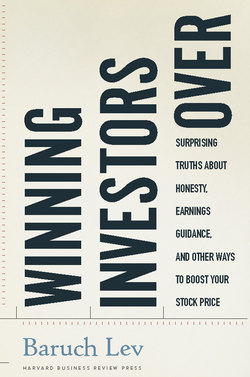Читать книгу Winning Investors Over - Baruch Lev - Страница 24
На сайте Литреса книга снята с продажи.
A Final Note on Visibility, Disclosure, and Stock Prices
ОглавлениеEmpirical findings, I learned long ago, have to make sense in addition to being statistically significant. How can the hiring of an IR consultancy increase share prices, as Bushee and Miller document? What's the process that leads from enhanced visibility and improved transparency, both important IR objectives, to higher market capitalization? Financial hocus-pocus? Not really. Here, briefly, is the important chain of events, where each link is supported by empirical research.43
An effective IR program reduces analysts' and institutional investors' costs of obtaining and processing information about companies and their growth prospects. This is done by improving the quality of information, such as systematically disclosing beyond-GAAP data, like drug companies' product pipeline or data on the effectiveness of restructuring efforts (see chapter 7). Also, improving information quality involves securing wide analyst participation and the quality of presentation in quarterly and annual conference calls, arranging media coverage for important company events, and making executives available for background discussions with analysts and major investors. The objective here is to reduce information costs for analysts and investors who are seeking information yet have limited attention.
Next, evidence indicates that improving information quality and investors' accessibility to information sources increases the number of analysts following the company and enhances institutional demand for its shares. This, in turn, increases the liquidity of the company's shares—the ability to buy or sell stock without a considerable price impact—a highly coveted share attribute by institutional investors, reflected by a high volume of share trade.44 The key here is that more analysts, buy- and sell-side, and improved analysts' product—earnings forecasts and stock valuations—enhance the stock's liquidity.
And, finally, since investors, institutions in particular, highly value liquidity, they are willing to pay a premium for it, requiring a lower rate of return on the stock. This ends the virtuous cycle, from effective investor relations to a higher shareholder value.
In sum, the various communication channels (conference calls, earnings releases) and information facilitators (investor relations, business media) I have analyzed in this chapter work their magic, when effective, through the following chain:
Reduction of information costs → increasing the number of analysts following and institutional investors' visibility → enhancing share liquidity → stock price and volume improvements
A company can achieve all this without a formal IR function, but trained and capable IR professionals undoubtedly facilitate the process from information to higher value, and conserve precious CEO and CFO time.
